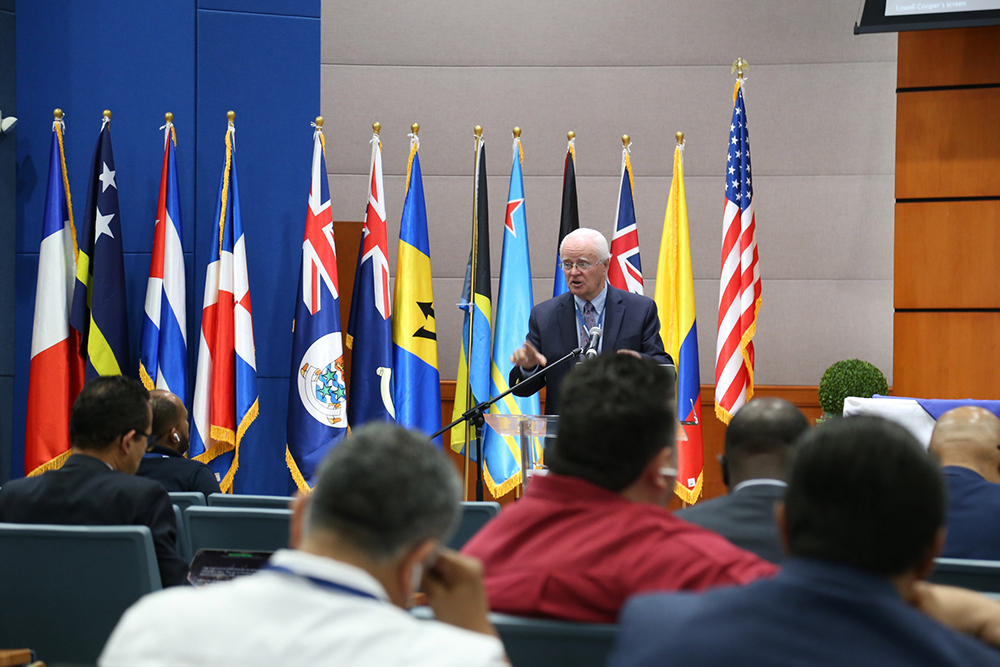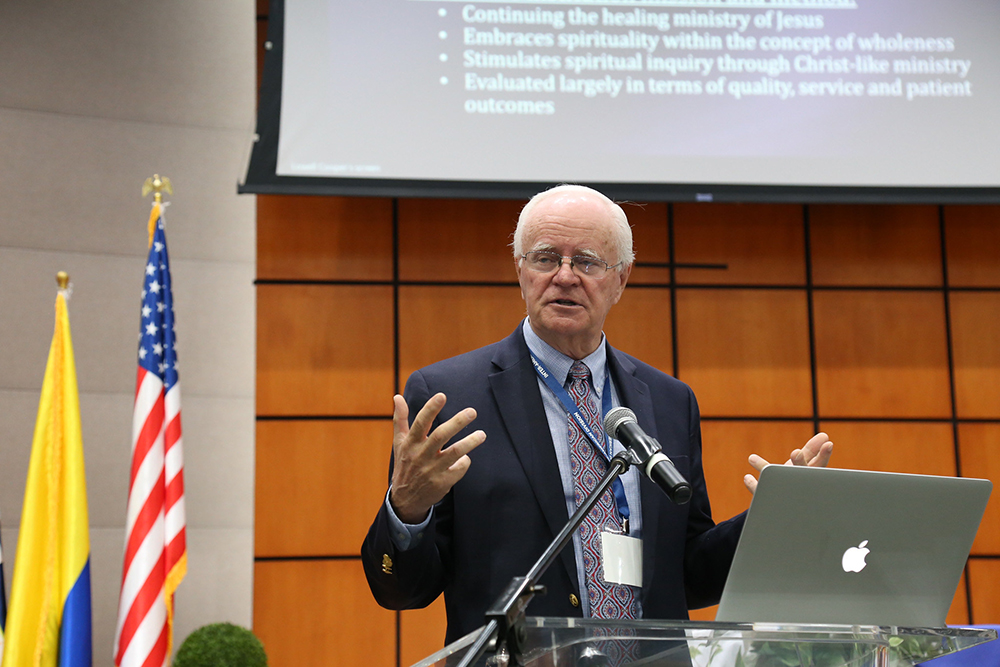Leader Discusses ‘What Every Adventist Board Member Should Know’
August 3, 2023 | Miami, Florida, United States | Marcos Paseggi, for Inter-American Division News
Even though the Seventh-day Adventist Church organization and its institutions are closely connected in mission and ultimate goals, their systems of governance are not the same, said retired former General Conference vice-president Lowell Cooper.
In a July 28, 2023, presentation to health-care institutions administrators, pastors, and advocates attending the Inter-American Division (IAD) Health Symposium in Miami, Florida, United States, Cooper discussed the basic differences between church governance and institution governance models. His special focus was on the almost 2,000 Adventist health-care institutions around the world, which include hospital and sanitariums, care facilities, and medical and dental facilities.

Lowell Cooper retired former General Conference vice-president Lowell Cooper addresses church and hospital administrators on day two of Inter-American Division’s Health Symposium, held in Miami, Florida, United States, July 28, 2023. [Photo: Libna Stevens/IAD]
Differences start from the beginning—right from their mission and methods, said Cooper. Church mission seeks spiritual renewal; focuses on worship, discipleship and proclamation; and it’s largely evaluated in terms of membership accessions,” he explained. “Health-care institutions seek to continuing the healing ministry of Jesus; embrace spirituality within the concept of wholeness; and are largely evaluated in terms of quality, service, and patient outcomes.”
Church-sponsored institutions are an expression of the church in mission, said Cooper. “Institutions fill unique roles in Church mission. They cannot go unnoticed or disrespected by ecclesiastical structure or measured in terms of membership acquisitions. Nor should institutions distance themselves from the church by independent mindedness and inattention to all dimensions of wholeness,” he said.
Cooper drove this point further. As regards alignment of the comprehensive health ministry with the church, he said, “institutions cannot move away from the Church and become independent, nor they can be treated by the Church as just one more congregation.”
Institutional identity
An Adventist health-care institution it’s not just a business, an enterprise; it is a faith-based ministry, emphasized Cooper. In that sense, ecclesiastical and institutional entities also follow similar but separate patterns regarding their identity. In the former, he explained, there is a constituency who reports to an executive committee, who nominate executive officers and administration. In the latter, the constituency elect a board of trustees, who elects a chief executive officer, who then reports to the administration.

Lowell Cooper said that “denominational policy and fundamental beliefs form a backdrop for institutional policy development,” during his presentation to dozens of administrators on Jul. 28, 2023. [Photo: Libna Stevens/IAD]
Governance, structure, and property
In the following minutes, Cooper set out to discuss other areas of differences between church and institutional organization, including structure, governance, property, and resources. He also mentioned differences between employees, policies, and what happens when a local church is located on an institutional campus. Below there’s a summary of the main takeaways of Cooper’s presentation.
“Ecclesiastical structure and institutional structure are not one and the same. Church entity is sponsor, not owner,” said Cooper. It is the reason institutions should be registered as a charitable, religious, and not-for-profit organization wherever possible, he explained. “Distinct structure isolates risk exposure and allows for business development not available to an ecclesiastical structure,” he said.
As regards governance, in the ecclesiastical system, each entity is part of a chain of organizations. In the institutional system, on the other hand, each entity is a “stand-alone” organization, even though “denominational institutions are not independent; they are inter-dependent,” Cooper emphasized.
It often happens that the chair of an institutional board is the president of a church region (often division, union, or conference), explained Cooper. In those cases, the church leader must serve with the best interest of the board he is chairing. “A church leader can wear many hats—but only one at a time!” he illustrated.
Property demands careful considerations, including to determine whether the property used by an institution owned, rented, or leased? If rented or leased, what are the terms? Widespread denominational practice is that title to real estate is held in the name of a Church entity corporation, he reminded his audience. That church entity corporation “holds title in trust for the institution. Transactions affecting the property will require approval from the title holding entity.
Resources, employees, and policies
As regards resources, there are multiple considerations, said Cooper. They include, among others, church entity appropriations to institutions, institution profit-sharing with Church sponsor, and employee tithe collected by institution. “Institutions that follow a tithe-deduction program need to have in place an employee authorization to do so,” Cooper said. “Returning tithe as an act of stewardship needs to be the person’s decision rather than the organization’s mandate.”
Overall, “any financial arrangement between a church entity and a church-sponsored institution needs to respect organizational boundaries,” he said.
Cooper also mentioned some employee-related considerations. He quoted the GC Working Policy, which states that “hospital and other health-care institutions shall make no distinction on the basis of race, color, or gender in admitting patients or in making their facilities available to physicians, interns, residents, nurses, and administrators who meet the professional standards of the institution. All organizations and institutions shall provide employment and advancement opportunities without regard to race, color, or gender to persons who qualify.”
Adventist health-care institutions face a significant hurdle as regards employment, Cooper conceded. “Health-care institutions… have the greatest challenge in attracting enough qualified church members to meet the employee needs of the institution. The central question is how to attract a workforce that individually and collectively implements the mission of the institution,” he said.
It is a matter of utmost importance, said Cooper, because it is the spiritual commitment and convictions of the institution staff that will create the institution’s reputation as providing “Christ-like ministry.” “In the recruitment process, it is vital that persons interviewed be made aware of the faith-based identity of the institution and of the spiritual dimensions of its mission,” he emphasized.
As regards policies, the institutional board is the policy-making body for the institution, Cooper said. In that regard, “denominational policy and fundamental beliefs form a backdrop for institutional policy development. And in some instances, denominational policy already predetermines certain aspects of institutional life.
A local church on campus
The GC Working Policy also contemplates the relationship between denominational entities and their local church, which, according to Cooper, “could be an area for potential tensions.” He explained that “in many cases, the church building may be located on the campus of the institution and a high percentage of the local church membership” are institutional employees. “In these situations,” he explained, “it is important to preserve a distinction between the functions of the institution and the role of the local church.”
The policy calls to “maintain a clear and mutually beneficial relationship with the local Seventh-day Adventist Church,” Cooper read. To achieve it, he said, “the administration of the institution and the pastors of the church will need to keep in frequent and mutually supportive communication in order for the life of institution and church to thrive.”